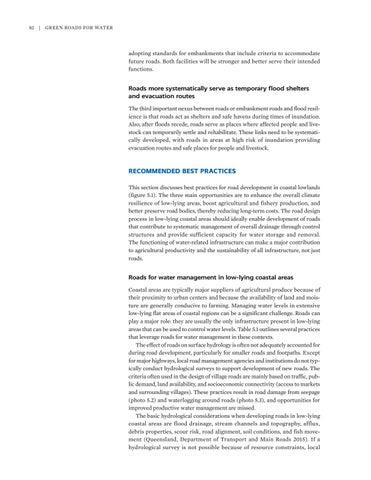82 | Green Roads for Water
adopting standards for embankments that include criteria to accommodate future roads. Both facilities will be stronger and better serve their intended functions.
Roads more systematically serve as temporary flood shelters and evacuation routes The third important nexus between roads or embankment roads and flood resilience is that roads act as shelters and safe havens during times of inundation. Also, after floods recede, roads serve as places where affected people and livestock can temporarily settle and rehabilitate. These links need to be systematically developed, with roads in areas at high risk of inundation providing evacuation routes and safe places for people and livestock.
RECOMMENDED BEST PRACTICES This section discusses best practices for road development in coastal lowlands (figure 5.1). The three main opportunities are to enhance the overall climate resilience of low-lying areas, boost agricultural and fishery production, and better preserve road bodies, thereby reducing long-term costs. The road design process in low-lying coastal areas should ideally enable development of roads that contribute to systematic management of overall drainage through control structures and provide sufficient capacity for water storage and removal. The functioning of water-related infrastructure can make a major contribution to agricultural productivity and the sustainability of all infrastructure, not just roads.
Roads for water management in low-lying coastal areas Coastal areas are typically major suppliers of agricultural produce because of their proximity to urban centers and because the availability of land and moisture are generally conducive to farming. Managing water levels in extensive low-lying flat areas of coastal regions can be a significant challenge. Roads can play a major role: they are usually the only infrastructure present in low-lying areas that can be used to control water levels. Table 5.1 outlines several practices that leverage roads for water management in these contexts. The effect of roads on surface hydrology is often not adequately accounted for during road development, particularly for smaller roads and footpaths. Except for major highways, local road management agencies and institutions do not typically conduct hydrological surveys to support development of new roads. The criteria often used in the design of village roads are mainly based on traffic, public demand, land availability, and socioeconomic connectivity (access to markets and surrounding villages). These practices result in road damage from seepage (photo 5.2) and waterlogging around roads (photo 5.3), and opportunities for improved productive water management are missed. The basic hydrological considerations when d eveloping roads in low-lying coastal areas are flood drainage, stream channels and topography, afflux, debris properties, scour risk, road alignment, soil conditions, and fish movement (Queensland, Department of Transport and Main Roads 2015). If a hydrological survey is not possible because of resource constraints, local







































